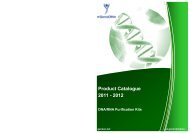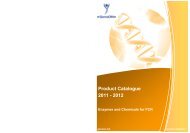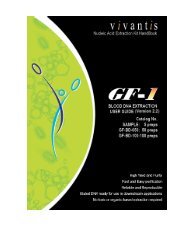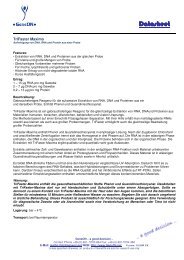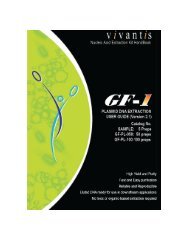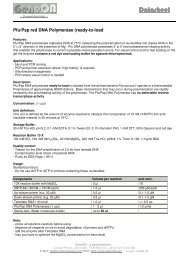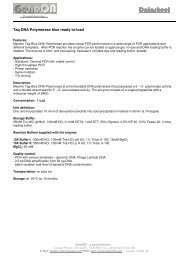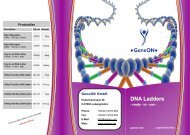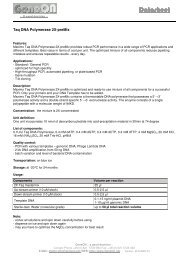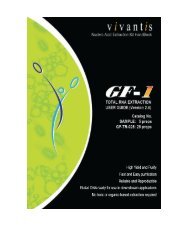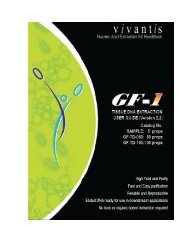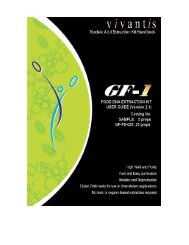GF-1 Blood Total RNA Extraction Kit
GF-1 Blood Total RNA Extraction Kit
GF-1 Blood Total RNA Extraction Kit
- No tags were found...
Create successful ePaper yourself
Turn your PDF publications into a flip-book with our unique Google optimized e-Paper software.
IntroductionThe <strong>GF</strong>-1 <strong>Blood</strong> <strong>Total</strong> <strong>RNA</strong> <strong>Extraction</strong> <strong>Kit</strong> is designed for the isolation of total <strong>RNA</strong>(longer than 200 bases) from up to 1ml fresh or frozen anti-coagulated whole blood.Samples are lysed in the presence of a specially formulated buffer which inactivatescellular RNases. Meanwhile, fragments of DNA are simply removed by applying thesample into a specially designed homogenization column followed by DNase I treatment.Optimized buffer and ethanol are added to provide selective binding of <strong>RNA</strong> onto thecolumn matrix while contaminants are efficiently washed away. High-quality <strong>RNA</strong> isthen eluted in RNase-free water. Isolated <strong>RNA</strong> is ready for use in downstreamapplications such as dephosphorylation, blotting, cDNA synthesis, etc. organic-basedextraction required<strong>Kit</strong> componentsProductCatalog No.Components5 PrepsSAMPLE25 Preps<strong>GF</strong>-TB-025Homogenization Columns 5 25<strong>RNA</strong> Binding ColumnsCollection tubes5102550Buffer BR* 2ml 10mlInhibitor Removal Buffer* 1.5ml 8mlWash Buffer* 3ml 15mlProteinase K* 0.11ml 0.55mlDNase I* 0.04ml 0.2mlDigestion Buffer 0.35ml 2mlDigestion Enhancer 0.04ml 0.2mlRNase-free Water 1.ml 10mlHandbook 1 1* Please refer to Reconstitution of Solutions and Storage and Stability.The <strong>GF</strong>-1 <strong>Blood</strong> <strong>Total</strong> <strong>RNA</strong> <strong>Extraction</strong> <strong>Kit</strong> is available as 25 purifications per kit.The reagents and materials provided with the kit are for research purposes only.
Additional Materials to be Supplied by User80% EthanolAbsolute Ethanol (>95%)-mercaptoethanolReconstitution of SolutionsThe bottles labeled Inhibitor Removal Buffer and Wash Buffer contain concentratedbuffer which must be diluted with absolute ethanol (>95%) before use.For SAMPLE (5 preps),Add 1.5ml of absolute ethanol into the bottle labeled Inhibitor Removal Buffer.Add 7ml of absolute ethanol into the bottle labeled Wash Buffer.DNase I is sensitive to physical denaturation. DO NOT VORTEX. Mix gently byinverting the tube. Prepare DNase I in 7ml aliquots to avoid repeated freeze-thaw cycles.Store at -20°C.For <strong>GF</strong>-TB-025 (25 preps),Add 8ml of absolute ethanol into the bottle labeled Inhibitor Removal Buffer.Add 35ml of absolute ethanol into the bottle labeled Wash Buffer.DNase I is sensitive to physical denaturation. DO NOT VORTEX. Mix gently byinverting the tube. Prepare DNase I in 7ml aliquots to avoid repeated freeze-thaw cycles.Store at -20°C.Store Inhibitor Removal Buffer and Wash Buffer at room temperature with bottlecapped tight after use.
Storage and Stability• Store all solutions (EXCEPT DNase I and Proteinase K) at 20°C-30°C.• Store DNase I and Proteinase K at -20°C.• Buffer BR is stable for 1 month after addition of -mercaptoethanol (prepare asneeded).<strong>Kit</strong> components are guaranteed to be stable for 12 months from the date ofmanufacture. Buffer BR and Inhibitor Removal Buffer may exhibit saltprecipitation due to cold temperature. If this occurs, simply warm the bottle at 55°C -65°C with occasional mixing until completely dissolved.Chemical HazardBuffer BR and Inhibitor Removal Buffer contain guanidine salts which can be harmfulwhen in contact with skin or swallowed. Always wear gloves and practice standard safetyprecautions. Do NOT disinfect guanidine or extraction waste in solutions containingbleach or any form of acid. To clean any items contaminated with the reagent, simplysoak in detergent and water to remove all traces of guanidine before cleaning with bleachor acidic solutions.
ProceduresReminders• All steps are to be carried out at room temperature unless otherwise stated.• Do not exceed 1ml of blood sample to prevent reduction in yield and purity.• Be certain not to introduce any RNases during the whole purification process. Weargloves at all times.• Pre-set waterbath to 65°C.• Add 10µl of -mercaptoethanol into 1ml of Buffer BR before use. Buffer BR isstable for 1 month upon addition of -mercaptoethanol.• For each purification, prepare the DNase I Digestion Mix as follows (prepare asneeded):DNase I 7µlDigestion Buffer 56µlDigestion Enhancer 7µlMix the DNase I Digestion Mix by gentle pipetting (DO NOT VORTEX). Store theDNase I Digestion Mix on ice while performing the initial steps of <strong>RNA</strong> extraction.1. <strong>Blood</strong> lysisAdd 400µl of blood sample into a clean microcentrifuge tube. Add 300µl ofBuffer BR to the blood sample and mix thoroughly by pulse-vortexing. Add180µl of RNase-free Water. Add 20µl of Proteinase K and mix immediately.Incubate at 65°C for 10 min.Ensure that -mercaptoethanol is added into Buffer BR before use. <strong>Blood</strong> samples mayvary in the number of leukocytes depending on the individual, age, health status of donorand storage time. Processing too many cells may lead to overloading of the glass filtermembrane. Therefore, ensure that there are not more than 5x10 6 leukocytes in thesamples. If sample volume is less than 400µl, add the same amount of Buffer BR butadjust the total volume to 880µl with RNase-free Water. If sample volume is more than400µl, adjust the volume of Buffer BR and RNase-free water proportionally.
2. Separation from cell debrisCentrifuge the sample at maximum speed for 3 min.3. Loading to Homogenization ColumnTransfer the lysate into a Homogenization Column assembled in a collectiontube. Centrifuge at maximum speed for 2 min. Save the flow-through.4. Addition of ethanolAdd 0.5 volumes of 80% ethanol to the flow-through. Mix thoroughly bypipetting.If the flow-through is more than 900µl, separate it into two tubes before the addition of0.5 volumes of 80% ethanol.5. Loading to <strong>RNA</strong> Binding ColumnAttention! Tips for Higher YieldIn order to obtain maximum yield, we strongly recommend users to fix the orientation ofthe column during centrifugation at all times. We recommend users to place the columnwhich has a triangle mark on the edge, at a fixed position during centrifugation.Transfer the sample, including any precipitate into a <strong>RNA</strong> Binding Columnassembled in a collection tube. Centrifuge at 10,000 x g for 1 min. Discard flowthrough.6. Column washing 1Add 500µl of Wash Buffer and centrifuge at maximum speed for 1 min. Discardflow-through.Ensure that ethanol has been added into Wash Buffer before use (refer to Reconstitutionof Solutions).
7. DNase I digestionPipette 70µl of DNase I Digestion Mix into <strong>RNA</strong> Binding Column and incubateat room temperature for 15 min.Some samples may have high genomic DNA content. Prolong the incubation time (to bedetermined empirically) if necessary.8. Inhibitor removalAdd 500µl of Inhibitor Removal Buffer and centrifuge at maximum speed for 1min. Discard flow-through.(Ensure that ethanol has been added into Inhibitor Removal Buffer before use (refer toReconstitution of Solutions).9. Column washing 2Add 500µl of Wash Buffer and centrifuge at 10,000 x g for 1 min. Discard flowthrough.Wash column again with 500µl of Wash Buffer and centrifuge at 10,000x g for 1 min. Discard flow through.Ensure that ethanol has been added into Wash Buffer before use (refer to Reconstitutionof Solutions).10. Column dryingCentrifuge the column at 10,000 x g for 1 min to remove traces of buffer.It is essential to remove traces of ethanol as it will inhibit downstream applications.11. <strong>RNA</strong> elutionPlace the column into a clean microcentrifuge tube. Add 40-60µl of RNase-freeWater directly onto the membrane and stand for 1 min. Centrifuge at 10,000 x gfor 1 min.Store <strong>RNA</strong> at -20°C or -80°C.Ensure that RNase-free Water is dispensed directly onto the center of the membrane forcomplete.
TroubleshootingPlease note that by not adhering to the recommended protocols, unsatisfactory resultsrelated to yield and quality of DNA may occur. If problems arise, please refer to thefollowing:Problem Possibility SuggestionsHomogenizationColumn CloggedLow <strong>RNA</strong> yield<strong>RNA</strong> degradation/smearingToo much starting materialLysate is too viscousColumn is not placed atfixed orientation duringcentrifugation80% ethanol is not addedprior loading onto <strong>RNA</strong>Binding Column80% ethanol is preparedwronglyInhibitor Removal Bufferand Wash Buffer arereconstituted wronglySamples not properlystoredInappropriate handlingReduce amount of startingmaterial in the subsequentpurification.Users may dilute homogenatewith additional lysis buffer.Place the column which has atriangle mark on the edge, at afixed position duringcentrifugation at all times.Repeat purification with newsample.Repeat purification with newsample.Please refer to "Reconstitutionof Solutions". Repeatpurification with new sample.Fresh blood sample should bestored at 4°C and processedwithin a few hours ofcollection.If not processed immediately,store the sample at -70ºCFrozen blood sample shouldbe thawed on ice.Use disposable plasticwareand plastic tips.
Problem Possibility SuggestionsEnsure that the purification isperformed in an RNase-freeenvironment.Wear gloves at all times.Genomic DNAcontaminationPoor performanceof eluted <strong>RNA</strong> indownstreamapplications80% ethanol is not addedprior loading onto <strong>RNA</strong>Binding Column80% ethanol is preparedwronglyLysate is not passedthrough HomogenizationColumn prior loading onto<strong>RNA</strong> Binding ColumnDNase I digestion is notperformed properly.Eluted <strong>RNA</strong> contains tracesof ethanol<strong>RNA</strong> degradedRepeat purification with newsample.Repeat purification withnew sample.Repeat purification withnew sample.Please refer to preparation ofDNA 1 Digestion Mix andpipette the DNase 1 DigestionMix directly onto themembrane.Ensure that the column isspun dried prior to elution.Please refer to problem"<strong>RNA</strong> degradation/smearing".



